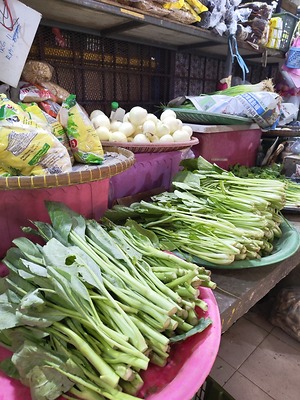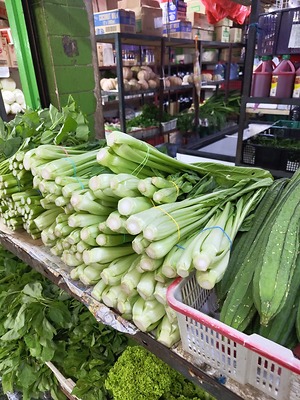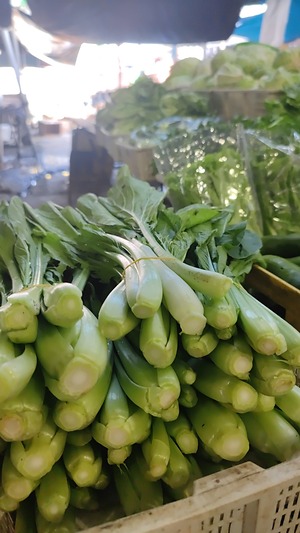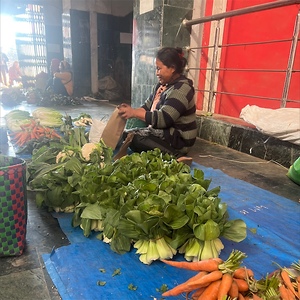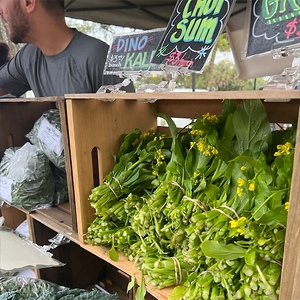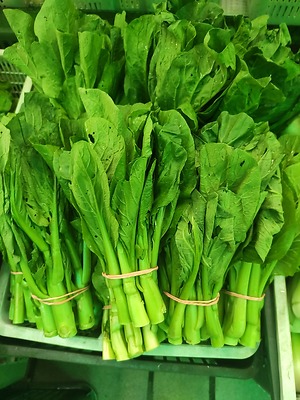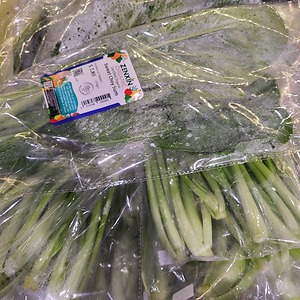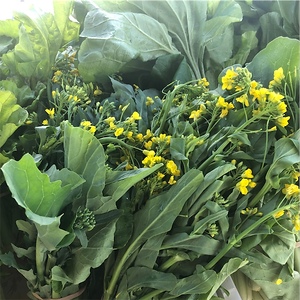


Choy Sum
Estimated Inventory, 30 lbs : 0
Description/Taste
Choy Sum varies in size and overall appearance, depending on the specific variety, and can be small, slender, and short or long with thicker, fleshier stems. Most greens sold under the Choy Sum name are comprised of pale to bright green stems that are straight in shape. The stems can be firm to slightly pliable, varying with age, and have a crunchy, succulent, and snappy consistency. Broad and flat dark green leaves top the stems and are deeply veined. The leaves also have a crisp and tender texture. Some greens sold under Choy Sum may bear unopened or slightly opened flower buds. These flowers are typically yellow and are edible with a slightly peppery taste. Look for Choy Sum with solid green stems, which can be determined by the cut end. If the center of the cut stem is white, it may be a sign of an older plant with a more fibrous nature. Choy Sum is edible raw or cooked, and younger versions are sweeter than older greens. The stems and leaves have a green, subtly vegetal, bittersweet taste with faint, mustard-like nuances.
Seasons/Availability
Choy Sum is available year-round, with a peak season in the winter and early spring.
Current Facts
Choy Sum, botanically classified as Brassica rapa var. parachinensis, is a category of herbaceous greens belonging to the Brassicaceae family. It is important to note that the term Choy Sum is a representative grouping of several types of non-heading cruciferous vegetables collectively sold for culinary purposes. Choy Sum is called Cai Xin or Caixin in Mandarin, which translates to “heart of the vegetable.” The most common variety sold under the Choy Sum name is Yu Choy, a green favored for its sweeter taste, fleshy stems, and tender leaves. In Western markets, the majority of Choy Sum seen in markets are Yu Choy greens harvested at different stages of maturity. In Asia, Choy Sum can include the sale of the hearts of other greens beyond Yu Choy, mainly Gai Choy or Mustard greens, and Asparagus lettuce. Each geographic region throughout China, Hong Kong, and Taiwan has varying definitions of what is sold under Choy Sum. Other regional names for Choy Sum include Choi Sum, Choi Sam, Tsoi Sum, Saishin in Japanese, Pakauyai or Pakaukeo in Thai, and Cai Ngot in Vietnamese. Choy Sum is traditionally a cool-season crop, and the slender, leaf-blade stalks are sold loose or in packaged bundles worldwide for use in savory, raw, or cooked culinary preparations.
Nutritional Value
Choy Sum varies in nutritional content, depending on the specific variety sold under this name. Cruciferous plants, in general, are a source of fiber to aid digestion and vitamins A, C, and K to promote faster wound healing, strengthen the immune system, and maintain healthy organs. Cruciferous greens also provide antioxidants to protect overall bodily health while reducing inflammation and minerals like iron, potassium, calcium, and phosphorus. Iron develops the protein hemoglobin for oxygen transport through the bloodstream, potassium balances fluid levels within the body, while calcium and phosphorus support bone and teeth health.
Applications
Choy Sum typically has a green, subtly bitter-sweet taste suited for raw and cooked preparations. The greens sold under this name vary worldwide, appearing small and tender to large, more elongated, and fibrous. Younger types of Choy Sum can be used fresh and are chopped into salads or lightly tossed with dressings as a crisp, refreshing side dish. Most consumers cook Choy Sum greens briefly to create a tender but still crisp consistency. If the stems are larger, it is recommended to peel the exterior layer to remove tough fibrous parts. The stems should also be separated from the leaves, as they require a longer cooking time. Choy Sum is famously stir-fried throughout Asia and is combined with sauces for light flavoring. In China and Taiwan, the cooked greens are often mixed with soy sauce to enhance their natural flavor without overpowering it. Cooked Choy Sum is also drizzled in shallot oil, oyster sauce, hoisin, or splashed with rice wine and served with meat and vegetables. Beyond stir-frying, the greens are braised, steamed, blanched, and boiled. Choy Sum is also frequently cooked into soups. A well-known Canton dish cooks Choy Sum in lightly salted water. After cooking, the liquid used to cook the greens is served with the stems and leaves. Drinking the vegetable broth is customary as it contains the nutrients from the greens. In addition to fresh preparations, Choy Sum is occasionally pickled as a tangy condiment. In Western countries, Choy Sum is adapted into quiche and other dishes like casseroles and pizza. Choy Sum pairs well with aromatics like garlic, shallots, ginger, spring onions, and chiles, shellfish, meats like beef, poultry, and pork, and five-spice, a spice blend of cloves, cinnamon, star anise, fennel, and Sichuan peppercorns. Whole, uncooked Choy Sum should be immediately used for the best quality and flavor. The greens can be stored for a few days when loosely placed in a bag and kept in the refrigerator's crisper drawer. Choy Sum can also be blanched and frozen for several months.
Ethnic/Cultural Info
Choy Sum is a central vegetable incorporated into Cantonese cuisine, a cooking style with origins in the Guangdong Province of Southern China. Guangdong has also been historically known as Canton and was the first region during the Qing Dynasty in the 18th century to be opened for trade in China with the rest of the world. The port city of Guangzhou became a hub for exchanging merchant goods, cultural practices, and culinary ingredients. This fusion of culinary flavors heavily influenced Cantonese cuisine, which focuses on using fresh, often seasonal ingredients and lightly cooking them to enhance, but not mask, true flavors. Choy Sum is a common winter vegetable, and the greens were favored for their mild flavor and versatility to be served as a simple side to more complex dishes. In the late 19th and 20th centuries, Cantonese families began to settle in Hong Kong, parts of Southeast Asia, and the United States. This expanded Cantonese cuisine's notoriety and the use of Choy Sum worldwide.
Geography/History
Choy Sum is native to China and is a product of centuries of selective breeding of various Brassica species. It is unknown when Brassica species were introduced from the Mediterranean region to Asia, but scientists hypothesize it occurred in ancient times. After their arrival, Brassica species were extensively cultivated and bred for specific traits, creating new varieties. Southern China was a central site for cultivation, especially during the Southern Song Dynasty in the 12th and 13th centuries. Many local varieties were produced over time, and beginning in the 1960s, structured breeding programs were established to grow plants with increased disease resistance and favorable cultivation qualities. Today, Choy Sum is widely grown in China and has expanded its cultivation to Hong Kong and Taiwan. It is also grown in smaller quantities in other countries in East and Southeast Asia, and as a specialty green in home gardens around the world. When in season, Choy Sum is found through fresh markets and retailers in Asia and through grocers and Asian markets worldwide.
Recipe Ideas
Recipes that include Choy Sum. One
| Serious Eats |
|
Stir-Fried Choy Sum With Minced Garlic |
| SBS Australia |
|
Tofu with mushrooms and choy sum |
| Yup, It's Vegan |
|
STIR-FRIED CHOY SUM |








